In 2023, global mobile app usage reached 257 billion downloads. According to predictions, this market will generate more than $613 billion in revenue in 2025. Although these are quite high-income potential, it is also a huge competition. To provide a high-quality solution, it is necessary to be aware of market strategies.
That’s why we’ve collected the hottest mobile app trends that will stay relevant in 2024. In this article, you’ll find our top picks from global dynamics to niche development. So let’s get started!
Now, let’s review mobile app trends in detail.
AI integration is one of the mobile app development trends, and it will continue to grow in 2024. Funding for AI startups increased to $38 billion during the pandemic alone by 2021. At the same time, healthcare companies started investing in AI the most (44%), compared to 22% of high tech.
By 2024, AI has affected almost every industry. Global spending on AI-enabled systems is worth $154 billion across all sectors. The two biggest investment industries are now banking and retail, with $20.6 billion and $19.7 billion in total.
Among the largest banks in the world, JPMorgan Chase, Capital One, and Royal Bank of Canada have the highest AI adoption. These mobile development trends transform banking apps into personalized services, fraud detection, and automated customer support.
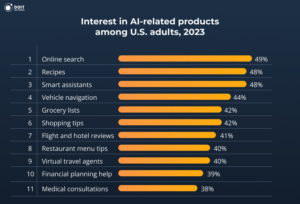
In turn, retail apps will focus on personalized shopping with AI-based recommendations. A survey among millennials and gen-zers showed that they are interested in AI-powered online shopping for 3 main reasons:
Among retail investors, the main reason for using AI was to help analyze specific stocks or assets. Thus, investment apps with robust artificial intelligence analytics will be in demand.
A good example is Prospero, an AI-powered investment research tool. It uses machine learning to analyze millions of real-time data points on stock performance. Prospero offers market conclusions through AI forecasts and an anonymous survey system.
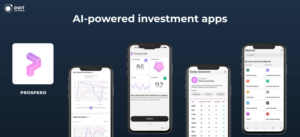
The fintech AI market grew to $44.08 billion in 2024, forecasted to surpass $50 billion by 2029. Among the fintech mobile app trends are smart financial advice, algorithmic trading, and secure AI transactions.
As for AI payments, younger respondents were more likely to use them in 2023. However, it remained low across all age groups. Most people still don’t feel confident with the idea of using AI in digital payments.
The use of AI in travel apps is also growing. 63% of U.S. travelers use AI for planning via a phone or tablet. Among the popular requests:
Besides, people often turn to virtual travel agents for help. This indicates a boost in the number of travel apps with chatbots. AI-enabled planning is also among the trending apps. For example, Taskade AI productivity. Powered by GPT-4, the app gained rapid popularity with 500k+ downloads in the Play Store. It is suitable for both work teams and personal planning. Taskade has features to answer complex questions, generate notes, and organize up to 500+ tasks.
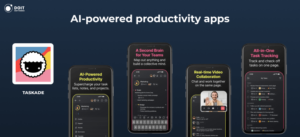
Almost half of US adults show interest in AI products, but 74% express concern about data privacy. So developers should take this into account to use this trend’s application potential.
Based on a Norton report, 71% of global adults are taking steps to protect their online privacy. Among them:
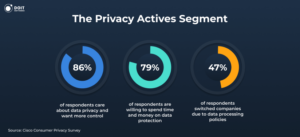
Cisco reported that 47% of adults have changed services due to their data policies. 33% replaced social networks, 19% – retail services, 18% – banks, and 13% – healthcare providers.
Companies must meet these application development trends to ensure user retention. As did DuckDuckGo, a popular private browser with 50m+ downloads in the Play Store. It is a cookie-free search engine that allows you to block web and app tracking and provides email protection. Currently, DuckDuckGo has about 793.8 million visits per month.
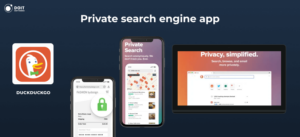
Demand for Virtual Private Network (VPN) apps has also increased. In 2022, the VPN market grew to $44.6 billion and is forecast to grow by 15.1%, reaching $137.7 billion by 2030.
Based on the latest data, there are more than 1.5 billion VPN users worldwide, and these numbers continue to grow. Thus, data privacy is one of the mobile app trends to follow in 2024.
Now let’s talk about the IoT as one of the mobile technology trends. Based on Statista reports, the total size of the global Internet of Things market in 2021 was about $213 billion. The forecast suggests that it will grow to over $621 billion in 2030. IoT apps generate 40% of this.
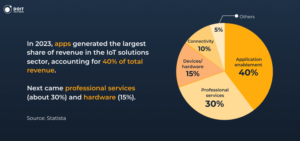
The IoT is popular in the industrial, smart city, and home technologies, sensors, automotive, and agriculture sectors.
Mobile apps are the interface for IoT devices. They provide direct interaction with gadgets and systems in various sectors. With their help, users can manage smart home settings, receive notifications, or check farming data. In fact, it is an advanced automation and user experience personalization in the IoT area.
A great example is Blynk. It is a no-code app builder where you can prototype, deploy, and manage connected electronic devices. This IoT app allows you to remotely control, receive real-time notifications, create automation, and interact with voice assistants.

Check out our article “20 Most Expensive Apps on the App Store: 2024’s Comprehensive Overview”.
According to a 2023 survey, 55% of smartphone users would like to purchase a foldable device as their next gadget. Thus, the development that supports these displays is one of the latest trends in mobile apps.
Forecasts show that the number of foldable smartphone shipments will grow from 18.6 million devices in 2023 to 100 million in 2027. Now Samsung is the leader in this market, with a 70% share. In 2019, this company launched the trend with the release of Samsung Galaxy Fold.
The main reason why consumers would buy a foldable smartphone is cheaper prices. However, 15% believe that a more durable screen and no display crease also influence their sales decision.
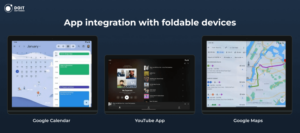
Many popular apps, such as Google Calendar and YouTube, have already adapted their interfaces to foldable devices. So now there are two ways forward for app developers: customizing existing solutions and creating new ones.
Low-code platforms simplify development by enabling users to create apps with limited or no coding. These tools use visual interfaces with drag-and-drop features. So, it makes app development accessible to non-technical users. This approach is one of the mobile app trends, that allow faster creation and deployment.

Gartner reports the low-code market grew to an estimated $26.9 billion in 2023. It’s projected that by 2026, 80% of low-code users will be from non-IT backgrounds. Spending on technologies enabling automation, including low-code, will reach $720 billion.
One useful example is Power Apps by Microsoft. This tool uses the Microsoft PowerFx low-code programming language and also allows AI development. Users can build an app from scratch with prompts or let the AI generate an app from images or Figma files. The tool offers prebuilt templates and drag-and-drop functionality. Power Apps is popular for use in finance, marketing, HR, and operations.
On-demand apps are mobile platforms that provide instant access to various services. For example, food delivery, ride-sharing, or home services. They connect consumers with providers, offering speed, convenience, and simplicity. On-demand apps continue to be one of the mobile application trends in 2024.
The largest on-demand category is online marketplaces. The top 3 players in the US market alone (Amazon, eBay, and Etsy) generate $158.3 billion in net profit. Let’s look at this market in more detail:
Among small and medium-sized businesses on Amazon, more than a third (35%) sell in the Home and Kitchen category. Besides, 26% of sellers operate in the Beauty and Personal Care category.
Transportation has been one of the mobile app trends since 2020 and continues to grow. The global car-sharing market will be worth about $226 billion in 2028. The number of users is expected to reach 1.97 billion. DiDi, Uber, and Lyft are the main players in the transportation app industry. Let’s take a closer look.
In 2023, the global online delivery market value stood at more than $1 trillion. The grocery delivery segment earned $390 billion of this, and the meal delivery was worth $630 billion. Online food delivery apps also owe their popularity to the Covid-19 pandemic. Here are some facts about this market:
Besides these 3 categories of on-demand services, home, freelance, and health and sports apps also gain popularity. When choosing one, users prefer the speed and quality. As Temu’s example shows, developers have the opportunity to build a trendy mobile app that wins even in a highly competitive market.
Digital banking is one of the latest app trends that both traditional companies and neobanks are adapting to. By 2025, the share of mobile banking users will reach 80.4% of the total population. And the percentage of US banks that offer mobile checkout is already 86%.
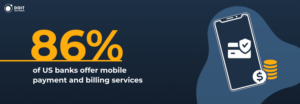
As of the end of 2022, US users installed mobile banking apps more than 34.6 million times. Capital One Mobile is the leader with more than 10 million downloads. JPMorgan Chase’s banking app, Chase Mobile, is in second place with 8.9 million downloads.
At the same time, neobanks continue to challenge traditional banks. A notable example is Chime. It is an app-only mobile banking service provider with 8.76 million downloads and 5.8 million monthly active users. In 2023, Chime became the most well-known and frequently used neobanking app in the US.

Moreover, the trend of digital banking apps is global. There are 462 of these services created since 2014. In Brazil, it is Nubank with approximately $3.9 billion in revenue. Japanese digital bank Rakuten has 136.3 million customers worldwide in 2023. The UK has Starling Bank with 160 thousand downloads.
38% of people switch to digital banking because of lower fees. 37.1% – due to faster money transfers. Among the most popular features of mobile banking are detecting breaches and receiving notifications of unusual account activity.
Wearable devices are now at their peak of popularity. In 2022, the number of connected wearables worldwide reached about 1.1 billion. And integrating software with these products, from smartwatches to smart glasses, is one of the hottest mobile app trends.
The growth of the wearables market is primarily driven by sales of smartwatches. Their worldwide shipments are forecast to grow from 37 million units in 2016 to over 402 million in 2027.
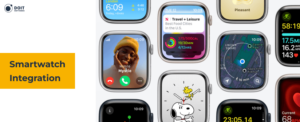
Companies are constantly updating their smartwatches to improve the user experience. For example, one of the biggest updates is Apple watchOS 10. It offers new ways to navigate and a new Smart Stack. It also features advanced workout options, a new mental health experience, and the ability to track the time you spend in daylight.
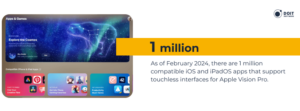
In February, Apple announced the release of 600 apps in the all-new App Store designed for Vision Pro. These apps feature fully touchless interfaces controlled by the user’s eyes, hands, and voice. Moreover, there are about 1 million compatible iOS and iPadOS apps that already support Apple Vision Pro. This is one of the most promising latest app trends, and in 2024, developers will be using spatial computing more.
Touchless options have already proven their value in 2020 at the peak of the COVID-19 pandemic. Their primary goal was to enable retail stores and offices to operate contactless. Thus, the world saw hundreds of technologies for remote access, document signing, and purchases using voice and gestures. But, in 2024, touchless technologies will be one of the hottest trends in mobile app development.
Touchless user interface (UI) options also include:
One example that we are all familiar with is biometrics access to the app. In most cases, it’s automatically supported by your smartphone, such as FaceID (facial recognition) or TouchID (fingerprint). Financial, document, or password storage apps use these features for security.

There are many biometric authentication apps with advanced features on the market today. For example, Duo Security by Cisco, or Keyless Authenticator. However, including biometric access in software that isn’t primarily focused on security is a new app trend.
There is a newer approach – gesture control. The technology has transformed the way we interact with our mobile devices. Smartphones can now recognize and interpret specific hand or body movements as commands by using sensors and cameras. This technology works by capturing motion in three dimensions. It analyzes gestures’ trajectory, speed, and shape against predefined patterns to execute commands within an app.
For example, Samsung’s Galaxy models support the Air action feature, where you can gesture with the S Pen to open apps, control music, and more. The company also launched Gesture Interaction for Smart TVs.

Eye tracking is a new app technology among contactless interface options. It uses state-of-the-art cameras and infrared sensors to track where and for how long the user is looking at the screen. This information is then used to control or adapt the app based on the user’s gaze. The technology assesses the pupil position and corneal reflection to pinpoint the user’s point of focus on the screen.
For example, Lumen uses this technology to turn standard webcams into eye-tracking tools. This allows them to conduct in-depth attention studies around the world. Their method combines eye tracking with face coding to optimize the impact of advertising and packaging.
Meanwhile, Tobii offers eye control for apps, using glasses. It is suitable for research, healthcare, education, and AR apps. They are also a great solution for people with disabilities.
![]()
Voice user interfaces are not only about the popular voice assistants Siri and Alexa. Still, they were the start of the function’s adoption. For example, PayPal has been enabling voice-activated payments via Siri since 2016. H&M, Starbucks, and American Express also implemented a similar function for quick searches or repeated payments. However, in 2024, the integration of VUIs will become one of the new mobile app development trends.

Voice interfaces allow users to interact with software using voice commands. Employing natural language processing (NLP) and machine learning, VUIs can understand, interpret, and respond to user queries with high accuracy. AI has also made a great input into this. This technology converts speech into text, analyzes it, and performs the appropriate action in the app.
VUI is a good option for home automation, gaming, accessibility features, and on-the-go tasks. However, it can also perform in niche applications, such as healthcare.
Blockchain technology is a decentralized digital ledger that records transactions across many computers. It operates by chaining together blocks of transactions, which are verified and encrypted. This mechanism creates a tamper-proof system, ideal for secure operations in various apps.
Although it’s not a new concept, this tech is also one of the mobile app trends in 2024. Let’s take a look at what the blockchain market looks like these days.
The blockchain tech integration into mobile apps opens up a wide range of use cases in various industries:
Financial Services
Enables direct, secure transactions, smart contracts
Supply Chain and Logistics
Offers real-time, transparent tracking from production to delivery. Ensures product authenticity through immutable records.
Healthcare
Secure sharing of patient records while maintaining privacy. Tracks the production and distribution of pharmaceuticals.
Government and Public Sector
Supports transparent, secure, and tamper-proof electoral processes.
Media and Entertainment
Enables creators to securely register and license their works. Facilitates direct, transparent transactions between creators and consumers.
Retail
Allows consumers to verify the authenticity of luxury goods and collectibles. Offers a transparent system for managing loyalty points and rewards.
Along with blockchain app development, the DApps industry has also become popular. Decentralized applications (DApps) are digital apps that run on a blockchain ledger. It works across many nodes (computers), so the application operates in a transparent, open, and secure environment. This decentralization means that DApps resist censorship, downtime, and control by a single authority.
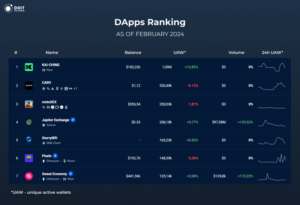
Key characteristics of DApps include:
DApps can span various industries. It includes finance (DeFi apps), gaming, social media, and NFTs. In 2024, DApps have 5.3 million daily unique active wallets.
The decentralized design of DApps offers both benefits and barriers. On the one hand, their open-source code promotes teamwork and innovation. Cryptographic tokens motivate users and increase security. But their growing popularity also highlights scalability and security issues. The DApps sector will continue to grow with new cybersecurity efforts in 2024.
In the first quarter of 2023, users downloaded about 27 billion applications from Google Play, and about 8.1 billion from the Apple App Store. Although these numbers differ, developers are turning to one of the mobile app trends – cross-platform development. This approach allows to building of software that runs on different mobile operating systems based on a single code base. It is a cost-effective and efficient way to reach a wider audience.
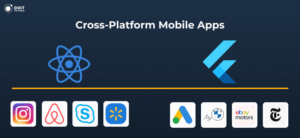
Cross-platform apps are gaining popularity due to their ability to provide the same user experience on iOS and Android devices. This not only speeds up the development cycle but also reduces costs, making it attractive to businesses.
Cross-platform development is popular among well-known brands, such as Instagram and Google Ads, as well as new launches. Although this is not a new trend, it will continue to grow in 2024.
Beacon-enabled apps work by interacting with small Bluetooth devices placed in specific locations. When a smartphone with an app comes within its range, it receives signals that make the app perform certain actions. For example, to send personalized notifications or offers to the user’s phone. This technology is one of the mobile app trends, as it allows companies to interact with customers in a targeted way, and improve user experience.
![]()
Forecasts say that the beacon market will grow from $519.6 million in 2016 to $56.6 billion by 2026. This technology will be increasingly used in retail, hospitality, and transportation.
For example, McDonald’s uses beacons to offer special deals when customers are nearby. Kroger enhances shopping experiences with in-store navigation and targeted ads. And Uber uses beacons to improve the accuracy of pick-up locations.
Forecasts say that by 2028, the number of AR and VR market users in the world will reach about 3.7 billion. And consumer spending on these content/apps will hit about $13 billion by the end of 2024. AR and VR are still in the implementation stage, so they will become one of the mobile app future trends shortly.
As of February 2022, there were 552 apps identified with the metaverse, of which about 23% were AR & VR ones. Now the number of such solutions is growing.

For example, Google Lens uses AR for real-world object recognition through smartphone cameras. IKEA Place, in turn, lets consumers visualize furniture in their homes before buying. Wanna Kicks enhances online shopping experiences with an AR feature for trying on sneakers virtually.
In the wearables trend we just discussed, we already mentioned the efforts of Apple Vision Pro. Analysts suggest that Apple may ship 350,000 devices in 2024, and up to 1.48 million in 2025. AR & VR apps for Apple Vision Pro and future versions will also become trendy.
The global mobile cloud market will reach $202.4 billion by 2028. The average annual growth rate will be 34.0%. Wireless technologies development, cloud computing, and 5G adoption are driving this growth. The market includes apps for entertainment, utilities, education, and healthcare.
Cloud technologies enable software to run faster. They offer storage solutions that increase app performance and improve customer experience. This way, users can access services and data from any device, anywhere, anytime. Moreover, the mobile cloud integration enables real-time data analytics, machine learning, and AI features.

In fact, 94% of businesses are already using cloud solutions. Thus, developers are taking advantage of cloud solutions more and more, making it one of the mobile app trends in 2024. Let’s take a look at some well-known examples of cloud-based mobile apps.
Salesforce
Business
CRM, sales tracking, marketing automation, real-time analytics
Google Workspace apps
Productivity
Collaborative editing, cloud storage, communication tools
Dropbox
File Storage
File syncing, sharing, collaboration tools, backup
Zoom
Meeting/Messaging
Video conferencing, screen sharing, real-time messaging, virtual backgrounds
Chime
Banking
Fee-free banking, automatic savings, early paycheck access
Google Photos
Photos and Video Sharing
Unlimited storage, photo and video backup, smart categorization
Apple Smart Home
Smart Home
Control and automate lights, locks, thermostats, and more with Apple's HomeKit ecosystem
Fitbit
Sport, Health
Activity tracking, sleep monitoring, workout logging, nutrition planning
Steam Link
Gaming
Game streaming from PC to mobile, multi-platform support, controller support
Focusing on audio and video features has become an important mobile app trend. It is transforming the way we communicate, interact, and consume content on our devices. This trend includes the rise of video-conferencing apps and audio-centric social media platforms.
The global shift to remote work and virtual meetings has increased the demand for video conferencing apps. In 2022, the global video conferencing market reached $10.6 billion. The market is forecast to nearly double by 2027, rising to $19.1 billion. These platforms have become essential tools for businesses, schools, and individuals.
Although they peaked in 2020, they are still popular. For example, in the 2nd quarter of 2023, users downloaded Zoom more than 38.4 million times worldwide. Microsoft Teams, in turn, increased the number of users from 270 million in 2022 to 300 million in 2023.
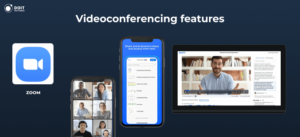
These programs are constantly evolving, adding new features. For example, Zoom announced the ability to take part in meetings through their Vision Pro headset. Besides, Zoom AI Companion allows you to generate a meeting summary, record through highlights, and get feedback on presentation skills.
There are many popular video-based social networks, such as YouTube and TikTok. But newcomers are also attacking the streaming entertainment space. For example, Caffeine. This is a network like TikTok that targets an urban African-American audience. The app offers content about rap battles, street dancing, etc. Now Caffeine has more than 1 million downloads in the Play Store.
Although video options are at their peak right now, audio social networks with live chat may also become one of the future mobile app trends. And Clubhouse is a vivid example of this. After its creation in 2020, the app broke into the top 20 most popular social networks in the US in just a year. Here are some facts about this network:

In fact, audio social networks are a new level of podcasting. Although the concept itself remains popular. The survey shows that 56% of the US population is familiar with podcasts, and 11% listen to them every day. And Spotify continues to be the most popular listening platform.
So, the key to a successful app lies in strong practices – functionality, user experience, and privacy. It’s not so much about chasing mobile app trends. It’s about using them to create safe, effective, and intuitive solutions. Any app demands a professional approach, and combining it with the market needs will only strengthen them. If you need to hire expert developers who can adapt the latest mobile app trends for your projects, contact us. We’ll provide the first CVs in a few days.
Get a consultation and start building your dream team ASAP.
REQUEST CVSAfter a downturn in 2022, annual app spending grew to $171 billion in 2023. Education, entertainment, and health apps had the largest increase in downloads.
Yes, mobile apps continue to be extremely popular: in 2023, the number of downloads worldwide reached 257 billion. Among the most demanded are games, messengers, and banking.
AI and machine learning, IoT, blockchain, AR & VR, low-code platforms, and cloud computing. Each of these technologies is frequently updated and provides new opportunities for mobile app development.










